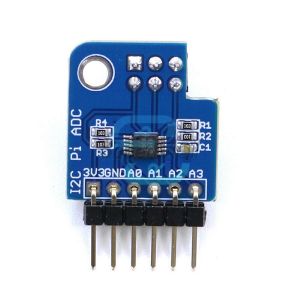Difference between revisions of "Raspberry Pi"
(links) |
m (+another link +photo) |
||
| Line 4: | Line 4: | ||
== How to use a Raspberry for analog data aquisition == | == How to use a Raspberry for analog data aquisition == | ||
| + | [[File:S-l1600.jpg|thumb|A simple I2C adapter for connecting an ADC chip to digital hardware (such as the Raspberry Pi). Note the digital output (top, below the board) and analog input (bottom).]] | ||
The Raspberry Pi does not have a general purpose Analog-to-Digital ([[ADC]]) or Digital-to-Analog ([[DAC]]) converter available on the GPIO pins. There are *hats* available which provide the neccessary hardware, for instance | The Raspberry Pi does not have a general purpose Analog-to-Digital ([[ADC]]) or Digital-to-Analog ([[DAC]]) converter available on the GPIO pins. There are *hats* available which provide the neccessary hardware, for instance | ||
| Line 9: | Line 10: | ||
* https://bc-robotics.com/shop/16-channel-analog-input-hat-for-raspberry-pi/ (USD 14) | * https://bc-robotics.com/shop/16-channel-analog-input-hat-for-raspberry-pi/ (USD 14) | ||
* https://www.seeedstudio.com/8-Channel-12-Bit-ADC-for-Raspberry-Pi-STM32F030.html (USD 9.90) | * https://www.seeedstudio.com/8-Channel-12-Bit-ADC-for-Raspberry-Pi-STM32F030.html (USD 9.90) | ||
| + | * https://www.ebay.de/itm/174058869127 8€, using the https://www.ti.com/product/ADS1115 | ||
The GPIO pins of the Raspberry Pi have CMOS logic levels (3.3V). Note that this is incompatible to TTL or +-10V [[Machine Unit|logic level]] of the THAT! Don't wire your THAT to the Raspberry Pi without logic conversion, otherwise you'll certainly break your poor Raspberry. | The GPIO pins of the Raspberry Pi have CMOS logic levels (3.3V). Note that this is incompatible to TTL or +-10V [[Machine Unit|logic level]] of the THAT! Don't wire your THAT to the Raspberry Pi without logic conversion, otherwise you'll certainly break your poor Raspberry. | ||
| Line 17: | Line 19: | ||
''Please collect your efforts of connecting [[The Analog Thing]] to a Raspberry Pi at this point!'' | ''Please collect your efforts of connecting [[The Analog Thing]] to a Raspberry Pi at this point!'' | ||
| − | == Photos == | + | == Raspberry Pi Photos == |
| + | === Photos === | ||
<gallery> | <gallery> | ||
File:Raspberry-Pi-2-Bare-FL.jpg|Typical Raspberry Pi (2B) with connectors. | File:Raspberry-Pi-2-Bare-FL.jpg|Typical Raspberry Pi (2B) with connectors. | ||
| Line 26: | Line 29: | ||
</gallery> | </gallery> | ||
| − | == Schematics and Drawings == | + | === Schematics and Drawings === |
<gallery> | <gallery> | ||
File:Drawing of Raspberry Pi model B rev2.svg|Drawing | File:Drawing of Raspberry Pi model B rev2.svg|Drawing | ||
Revision as of 12:43, 7 October 2021
The Raspberry Pi is a small single-board computer known for allowing to hack with hardware thanks to it's general purpose input/output (GPIO) pin header. The computer also has an Audio input/output, but the GPIO header has no analog-to-digital (ADC) converters. It can however be interfaced to any custom extension boards with 3V3 logic.
For further information, go to the English wikipedia article about the Raspberry Pi
How to use a Raspberry for analog data aquisition
The Raspberry Pi does not have a general purpose Analog-to-Digital (ADC) or Digital-to-Analog (DAC) converter available on the GPIO pins. There are *hats* available which provide the neccessary hardware, for instance
- https://bc-robotics.com/shop/16-channel-analog-input-hat-for-raspberry-pi/ (USD 14)
- https://www.seeedstudio.com/8-Channel-12-Bit-ADC-for-Raspberry-Pi-STM32F030.html (USD 9.90)
- https://www.ebay.de/itm/174058869127 8€, using the https://www.ti.com/product/ADS1115
The GPIO pins of the Raspberry Pi have CMOS logic levels (3.3V). Note that this is incompatible to TTL or +-10V logic level of the THAT! Don't wire your THAT to the Raspberry Pi without logic conversion, otherwise you'll certainly break your poor Raspberry.
The Raspberry Pi has Analog output, realized with PWM (pulse width modulation). This is not high quality but can be used for feeding analog data into THAT.
Efforts of connecting The Analog Thing to a Raspberry Pi
Please collect your efforts of connecting The Analog Thing to a Raspberry Pi at this point!
Raspberry Pi Photos
Photos
In this revion, the Audio input clearly stands out as blue 3,5mm jack








